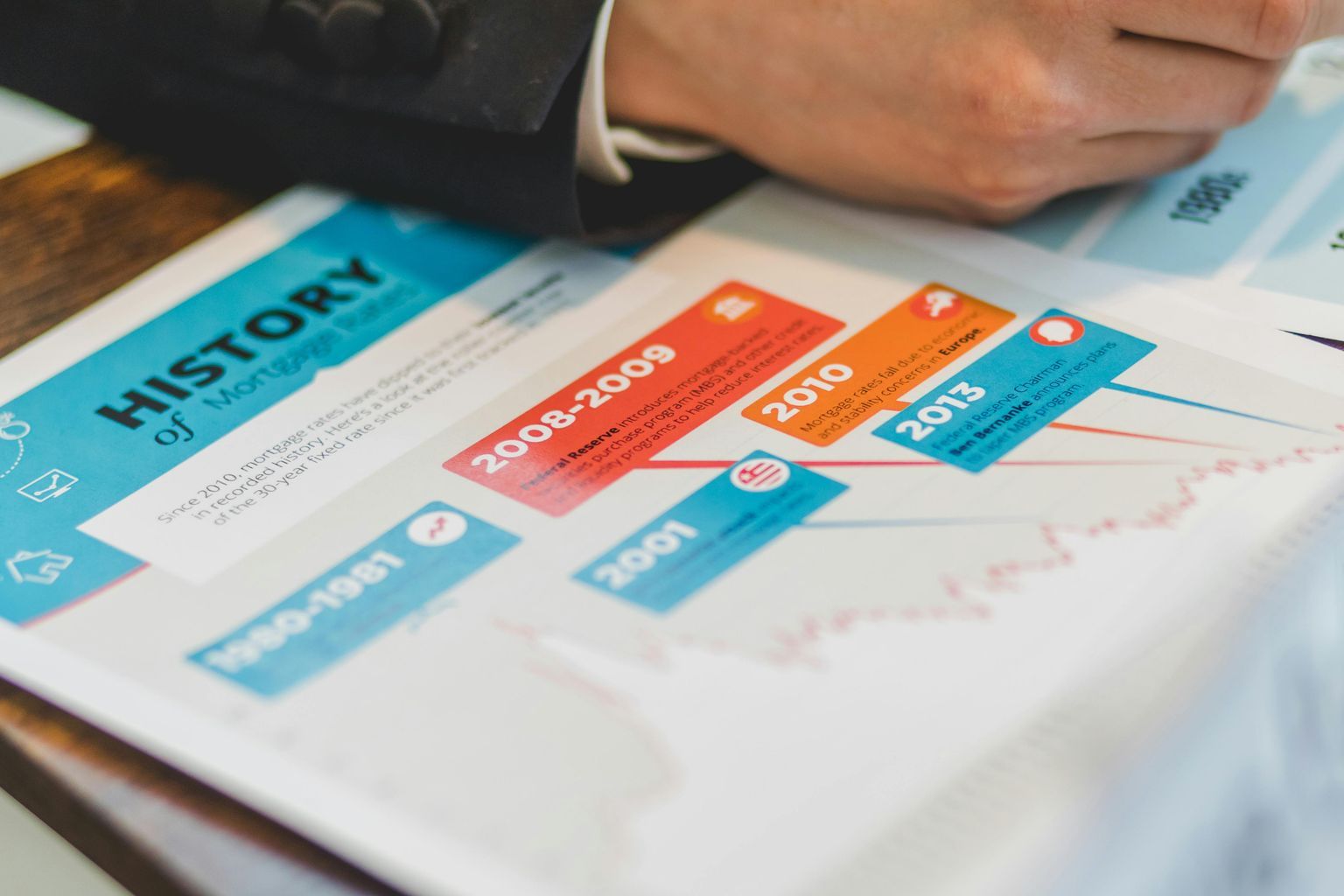Gaining insight into historical mortgage rates in Pasadena can assist you in making informed decisions when purchasing a home. Mortgage rates indicate the interest expenses associated with borrowing money for real estate. These rates have fluctuated significantly over time. This article examines how rates in Pasadena align with current trends in California and their implications for homebuyers. Having this knowledge may enable you to obtain the most suitable mortgage for your situation.
Overview of Mortgage Rates in Pasadena
The current mortgage rates in Pasadena show a 30-year fixed mortgage at 6.364% and a 15-year fixed at 5.385%. This aligns with recent trends across California, where rates have fluctuated over the years. Historical data indicate that, over the past decade, Pasadena has experienced both highs and lows in mortgage rates, which can impact buyers’ home purchasing power.
Factors contributing to these rate changes include the overall housing market conditions, median home prices, and local economic influences such as job growth. When rates rise, property data often shows a slowdown in buying activity, while lower rates can increase demand and drive appreciation. Refinancing opportunities remain popular, and many look for refinance savings as rates decrease. Trusted lenders often advertise financial products like FHA loans, VA loans, and USDA loans, helping buyers navigate their options within their homebuying budget.
Down payment assistance and equity builder loans are helpful tools, as thehomeownership rate continues to evolve with varying credit scores among buyers. Bankrate scores reflect competitive offerings from local loan officers and advertising partners in this dynamic market.
Historical Mortgage Rates Pasadena: A Timeline
Historical mortgage rates in Pasadena have experienced notable changes influenced by various events and trends. Over the years, average rates have shifted due to alterations in the housing market, economic conditions, and policy changes. For instance, the introduction of FHA loans and VA loans provided more options for buyers, resulting in a rise in homeownership rates.
Reports from reliable lenders indicate that the median home price in Pasadena has increased, prompting many homeowners to refinance in order to lower their monthly payments or access equity; savings from refinancing can be substantial. When examining price statistics, the rates frequently align with broader California averages, revealing variations during economic downturns and periods of low interest.
Trends in these historical rates indicate that as credit scores improve and homebuying budgets are adjusted, competition for homes may grow, particularly with advertising partners promoting equity builder loans and grants for first-time buyers. This could drive further changes in the Pasadena housing market, affecting future mortgage rates and options such as conventional loans and USDA loans.
Factors Influencing Historical Mortgage Rates in Pasadena
Economic indicators such as interest rates, home prices, and the homeownership rate have influenced mortgage rates in Pasadena. As the economy improves, the demand for housing increases, leading to higher prices; for example, with median home prices rising, buyers may find conventional loans and FHA loans more appealing, which can influence average rates.
The appreciation of the local housing market affects refinancing options and equity, prompting buyers to consider refinancing for better rates and savings. Regional and national policies, including the availability of USDA loans and VA loans, also shape the area’s mortgage offerings, impacting the choices of buyers and loan officers. Trusted lenders adjust their financial products based on these policies, enhancing the mortgage rate table with various options like the equity builder loan, which helps first-time buyers with down payments and grants.
Comparing Historical Mortgage Rates Pasadena with State Averages
Over the last decade, historical mortgage rates in Pasadena have often been close to state averages, with slight variations. For instance, as of late 2024, Pasadena’s 30-year fixed mortgage rate is 6.364%, while California’s average is 6.41%. Factors like local market conditions, median home prices, and homeownership rates can explain differences.
For example, Pasadena’s strong real estate market may lead to higher demand, influencing rates.
Additionally, property data shows that appreciation in home values can affect refinancing options, impacting mortgage rates. Fluctuations in rates can be reflected at the state level, affecting potential buyers’ homebuying budgets. Those seeking loans may consider conventional loans, FHA loans, VA loans, and USDA loans while also looking for refinance savings. Awareness of mortgage rate tables can help buyers compare options from trusted lenders.
Programs like the equity builder loan and grants for down payment assistance can provide support in a competitive housing market, encouraging informed financial choices in home purchases. A better credit score can also enhance opportunities for securing favorable mortgage rates.
Impact of Economic Trends on Mortgage Rates
Inflation and Interest Rates
Inflation often causes interest rates to rise, impacting mortgage borrowing directly. Higher interest rates can result in increased costs for home loans, making it more challenging for buyers to afford the median home price.
For example, when inflation increases, lenders may raise rates to address reduced purchasing power, as reflected in the current mortgage rate table showing rates around 6.41% for a 30-year conventional loan. This shift affects consumer behavior, as potential buyers may be reluctant to apply for mortgages due to worries about affordability. During these times, many explore refinancing their existing loans to secure better rates, leading to a surge in refinancing activity, including the 12,000 noted recently. Homebuyers can strategize their purchases by monitoring inflation trends and understanding their impact on rates.
They should also review their credit scores and investigate different financial options like FHA loans, VA loans, and USDA loans, which can assistwith down payment concerns. Moreover, reliable lenders might provide grants or equity builder loans to aid buyers in managing housing market challenges.
Housing Market Supply and Demand
Fluctuations in the housing market supply and demand affect mortgage rates in Pasadena significantly. When demand for homes increases, home prices often rise, leading to higher median home prices. This can cause interest rates to go up as lenders adjust their mortgage rate table to reflect increased risk. External economic factors, such as employment rates and inflation, further shape this balance.
If the economy is strong, more buyers are likely to enter the market, increasing competition for homes. This can push prices even higher, impacting homebuyers’ budgets.
Additionally, as property data shows appreciation in home values, buyers must consider grants or assistance programs like FHA loans, VA loans, or USDA loans for down payments. When demand softens, refinancing becomes attractive, allowing homeowners to seek better interest rates and increase their equity. By improving their credit scores, buyers can access lower rates from trusted lenders, which helps them save on refinancing costs. Dedicated service from a loan officer can guide buyers to find the best home loans that match their financial products and situation.
Current Mortgage Rates in Pasadena
Current mortgage rates in Pasadena are at 6.364% for a 30-year fixed loan and 5.385% for a 15-year fixed loan, slightly above the national averages. Recently, rates have shown minor fluctuations, with the 5-year adjustable-rate mortgage (ARM) at 7.586%. These changes relate to a broader trend in the real estate market, influenced by factors such as the rising median home price of $886,560 and an increase in the homeownership rate, now at 55.8%.
The appreciation in property values makes affordability challenging for many buyers, affecting their homebuying budget. As refinancing options become more appealing, borrowers consider savings through programs like FHA loans and VA loans, while conventional loans remain favored among buyers. Trust in reliable service and information from reputable lenders is important, especially when referencing mortgage rate tables and bank rate scores to make informed decisions.
Additionally, assistance programs, including equity builder loans and down payment grants, are available to help potential homeowners navigate this environment effectively.
California Mortgage Trends in Pasadena
Recent trends in California’s mortgage market show that Pasadena’s average rates are slightly lower than the state averages, with the 30-year fixed rate at 6.364% compared to the state’s 6.41%. The median home price in Pasadena reflects the larger California housing market’s appreciation, which saw a 6.5% increase year-over-year, making homeownership a challenge for many buyers.
Local economic factors, such as job growth and property data, influence current mortgage rates and lending practices, impacting homebuyers’ credit scores and down payment requirements. To navigate these trends, buyers can pursue various financial products like FHA loans, VA loans, and USDA loans, along with conventional loans.
Additionally, they might benefit from programs such as the equity builder loan or grants that support down payments. With tools from trusted lenders on Bankrate, prospective homeowners can assess mortgage rate tables, calculate refinance savings, and establish a strong homebuying budget by enlisting the help of a dedicated loan officer, ensuring they access the best deals available.
Refinance Rates and Their Historical Context
Historical trends in refinance rates in Pasadena have shifted alongside mortgage rates, reflecting the larger housing market. For instance, as interest rates declined, more homeowners sought conventional loans or FHA loans, resulting in an increase in refinancing activity. Economic events, such as financial crises or shifts in economic policy, have historically caused volatility in these rates.
When rates fall, buyers often rush to refinance, aiming to lower their monthly payments and access equity through equity builder loans. This behavior impacts the housing market, as lower rates lead to increased sales, which in turn influences median home prices. Advertising partners often highlight these trends in their mortgage rate tables, providing property data and price statistics. Trusted lenders report increased applications during favorable economic conditions, with many borrowers focused on enhancing their homebuying budget.
The homeownership rate in Pasadena also fluctuates with the these rates, and as buyers improve their credit scores, they become more inclined to take advantage of refinance savings. In this changing environment, dedicated service from loan officers remains important for navigating these financial products.
1. Tips for Homebuyers on Navigating Historical Mortgage Rates
Understanding Market Conditions
When assessing current market conditions for mortgage rates in Pasadena, individuals should consider interest rate averages, median home prices, and the homeownership rate. For instance, the average mortgage rate is currently around 6.364% for a 30-year fixed mortgage. Understanding housing market changes with property data and appreciation helps buyers make informed choices. Economic trends impact these conditions, as rising rates can affect affordability and refinancing opportunities.
Information like refinance savings can guide homeowners when considering FHA loans, VA loans, USDA loans, and conventional loans. By checking mortgage rate tables and bankrate scores from trusted lenders, buyers can evaluate their homebuying budget. Programs like the equity builder loan and down payment grants enhance potential buyers’ financial options.
Engaging with a dedicated service and a knowledgeable loan officer can help navigate this complex environment, ensuring they understand price statistics and secure the best financial products available.
Timing Your Purchase
Homebuyers should consider current mortgage rates, median home prices, and their financial situation when determining the right time to purchase a home. In Pasadena, for example, the average mortgage rate for a 30-year fixed loan stands at 6.364%. Buyers should also research local real estate trends, including property data and appreciation potential. If the housing market is cooling, lower prices and better refinancing rates may present an opportune moment to enter the market.
Paying attentionto bankrate scores, such as interest rate averages, is important. Buyers should track the homeownership rate, which indicates market stability and demand, and seek out trusted lenders who offer various loan options like FHA loans, VA loans, and conventional loans. Indicators like a decline in average days on the market can suggest competitive pricing. Tools like a mortgage rate table help buyers compare rates easily.
Additionally, looking into grants or equity builder loans can provide further down payment assistance, informing a homebuying budget.
Exploring Different Lending Options
In the housing market, the differences between fixed-rate and adjustable-rate mortgages can significantly impact a buyer’s financial situation. Fixed-rate loans offer stable monthly payments, facilitating budgeting, while adjustable-rate mortgages may begin with lower rates but can fluctuate, resulting in increased costs over time. Buyers should examine which lending option aligns with their long-term goals by considering their homebuying budget and potential property value appreciation.
Affordable options like FHA loans and VA loans may attract first-time buyers, while conventional loans might provide better terms for those with higher credit scores. When comparing lenders, it’s vital to review interest rates, fees, and bank rate scores to ensure reliable service and support. For instance, checking a mortgage rate table can assist in identifying the best available rates. Grants and specialized services, like those from loan officers, can provide additional assistance.
Furthermore, refinancing can offer savings by capitalizing on rate averages, utilizing options like the equity builder loan, and enhancing overall homeownership rates.
FAQ
What were the average mortgage rates in Pasadena over the past decade?
Over the past decade, average mortgage rates in Pasadena fluctuated between 3% and 5%. For instance, in 2013, rates were around 3.5%, while in 2021, they dropped to about 2.8%. Check reliable financial sites for current rates to make informed decisions.
How do historical mortgage rates in Pasadena compare to the national average?
Historical mortgage rates in Pasadena often mirror the national average but can vary based on local economic factors. For example, if the national average is 3.5%, Pasadena rates might be slightly higher, around 3.7%. Check local lenders for current rates to make informed decisions.
What factors have influenced changes in mortgage rates in Pasadena historically?
Mortgage rates in Pasadena have historically been influenced by factors such as Federal Reserve policies, local economic conditions, housing demand, and inflation rates. For example, a Fed rate hike can lead to increased mortgage rates, while a strong job market may boost demand and stabilize rates.
How can I find more detailed historical mortgage rate data specific to Pasadena?
You can find detailed historical mortgage rate data for Pasadena by visiting local lenders’ websites, checking the Federal Reserve Economic Data (FRED) website, or using real estate websites for regional trends. Additionally, consult local real estate agencies for specific historical insights.
What impact do historical mortgage rates have on current home-buying trends in Pasadena?
Historical mortgage rates influence current home-buying trends in Pasadena by affecting affordability. Lower rates often boost buyer demand, leading to increased competition and higher home prices. Buyers can take advantage of current rates to secure homes before potential increases, emphasizing the need for timely action.
Learn about the historical mortgage rates in Pasadena with Champions Mortgage. Our team can provide valuable insights into past trends to help you understand the market and make informed decisions for your home financing. Contact us today to explore how historical data can guide your mortgage strategy.







